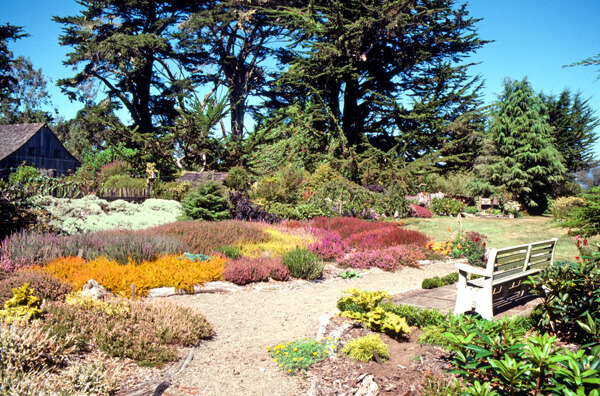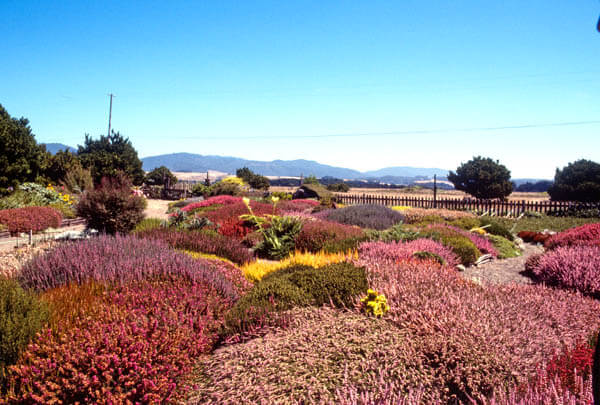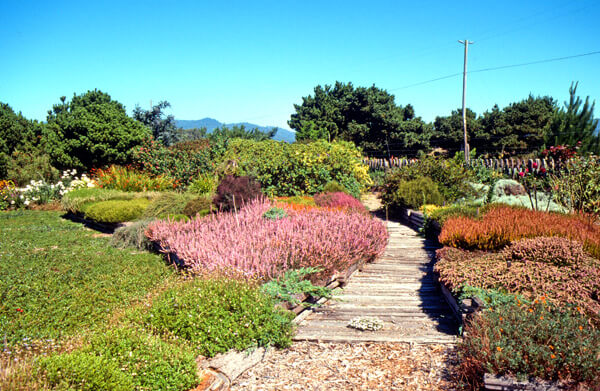
The Pacific Coast becomes a cold, damp and windy world, sandwiched between Pacific Palisades and redwood forested hills along Highway 1 in Mendocino, California. The windswept tableland is brutal for most plants but grasses. Native Monterrey cypress (Cupressus macrocarpa) trees are capable of standing up to the wind, too. Many century-old cypress windbreaks are found around coastal towns like Mendocino. With the tree’s protection, and the right plants, a late friend of mine created a wind garden designed with spit-and-polish military attention to detail.
The Beginnings of a Wind Garden

When the Army Colonel retired from a life of world travel, he bought part of an old coastal homestead and made a garden around its redwood barn. From his small house he could sip whiskey and look out to the Pacific Ocean across a wide grassland dotted with volunteer cypress. This garden would have to preserve that view, so the veteran began his odyssey of growing low, moorland heaths (Erica spp.) and heathers (Calluna spp.) in his cool coastal garden. The high rainfall and cold, windy weather is what these UK natives are adapted to, and the maritime Pacific Coast allows cultivation of nearly all of them.
The beauty of these plants is their tiny bell-shaped blossoms that bloom through most of the summer. Changes in fall foliage colors lend a patchwork of heights and textures. The large flat garden was threaded with bark-chip pathways. Because moors are well drained and Mendocino is on clay soil, the Colonel created raised planting islands, using his military gabion training, then filled them with organic, acid soils. He elevated them to no more than a foot or two – just enough to keep the plants dry. Today there is no visible sign of these underpinnings of the plants, but now you know the secret too.
My friendship with the Colonel goes way back to the beginning of this garden. Most of the early plants were propagated from cuttings outdoors in a slotted, sloping, south-facing cold frame. This allowed one rare heather to be used as a propagation plant to generate many more.
Wind Garden Perimeter Plantings

Around the fenced perimeter of the garden, the Colonel planted native rhododendrons and dwarf conifers to create a green background for the hot-colored heather foliage. Because the plants themselves can be so vivid, the flowers seem secondary, except that they excel as cut flowers. And while the flowers last a short season, heather stems maintain their color, and may even grow brighter during certain times of year.
The original plan for this garden was to add many diverse plants tucked around the old homestead. It was a true collector’s garden. But now, Vinca minor threatens to take over the disintegrating farm house and remnants of the old garden’s Victorian camellias, still bloom. Such is the power of low-growing plants to thrive within the confines or protection of large old evergreen trees. It proves that little can thrive in this wind unless provided consistent care and protection, unless specially adapted to the harsh growing conditions.
Creating Your Own Wind Garden

With high-quality Black Gold Canadian Sphagnum peat moss, anyone can copy this growing method for heaths and heathers along the West Coast. Since few have the porous, peaty ground of the moors, raise the plants up by 6 to 12 inches with sideboards or dry rock walls, then mix the peat in with the ground soil at a 2:1 ratio for ideal soil at the root zone.
There are hundreds of species and varieties of heaths and heathers with widely differing cold hardiness requirements, but the hardiest hail from the British Isles. The Colonel believed they could grow along California’s difficult windy coast, and he proved it with his North Coast garden. It shows that growing plants in the wind is about adaptation and a military-level awareness of site conditions.
“Start with the perimeter, protect your assets and hunker down,” he told me one day. “It’s how we always do it in the U.S. Army during the winds of war.”

